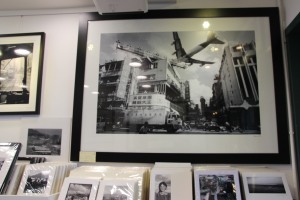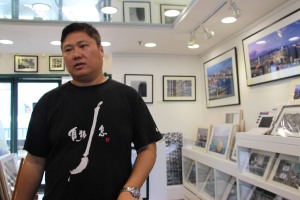By Stella Hou
Student Journalist, HKBU
2014/12/4
1101 words
An airplane is landing narrowly almost 500 feet above buildings. Below it, a steady stream of trucks, taxies and motorbikes are passing by a crossroad while people are walking normally, looking ahead.
This photo is 28*40 inches, black and white, hanging in Laurence Lai’s Gallery as an outstanding work in his 10 square meters gallery at Central Ferry Piers. On the back, it says “an airplane landing at Kai Tai Airport”. The photo is shoot by Lai at one noon in 1998. It was in this year that Kai Tai Airport was abandoned.

“Cha-cha, cha-cha. It was less than one second but the preparation was three months,” Said Lai, raising his hands in a gesture as pressing the shutter.
Kai Tai Airport, located on the west side of Kowloon Bay in Kowloon, is former civil airport in Hong Kong. Once, in 1996, it was the third busiest airport in the world in terms of international passenger traffic. Another reason makes it famous is that the airport is surrounded by high buildings. Some passengers claimed to have glimpsed the flickering of televisions through apartment windows along the final approach.
Lai regards Kai Tai Airport as one of the most impressing scene of old Hong Kong. In his three months’ preparation, Lai came to different corners of streets in Kowloon, always with four different lenses and two camera bodies. Eventually, he captured the moment at noon with his Nikon F90 film camera and 24mm f2.8 D lens.
Now, this photo has been sold half a million copies in different sizes from A3 to 28*40 inches since Lai’s gallery opened in 2001.
Lai prefers to call himself a street documentary photographer. Sham Shui Po, Sheung Wan and Hollywood Road are Lai’s purlieu for three day in a week, which are also places Lai’s mother always took him to when he was a child. In Lai’s opinion and memory, these places represent real Hong Kong.
Over a half of his photos are black and white. Lai prefers to apply it on historical moments, which help audience concentrate more on the object itself.
“I always feel that I have a mission to record what is happening in the street because it is a kind of culture,” Lai said.
In Lai’s eyes and lens, skyscrapers are always up and down, Starbucks and Macdonald can be seen everywhere, “but these have no meaning, this one is real Hong Kong actually,” Lai said, pointing one photo showing an tailor man is using sewing machine on the street.
Besides this tailor man, Lai has dozens of portraits which showing people selling vegetables or people delivering newspapers. Before taking photos of them, Lai always spends half an over talking with them to understand their work and feeling, which Lai treats as a way to respect them.
“It was people like them that work hard all their lives. That’s why Hong Kong becomes an international city now. So don’t forget history, I want to focus on development of this city to remind people of them.”
The motivation of him is simple. As Lai said, it’s his love for this space.
Before 2001, Lai was not a street documentary photographer yet. He was a businessman who ran his own trade company. Initially, photography is a hobby. Lai stared to sell his photos on Sunday free market in Tuen Mun with a table and an umbrella.
From Monday to Friday, Lai was businessman while at weekends he sold his own photos. “One day, I asked myself, what do you like most,” finally, Lai’s answer was to be a full-time photographer.
“All my friends asked me, are you crazy? Yes I think so, I want to do what I like.”
As Lai said, his confidence comes from his first photo sold on this free market. It’s a photo of sunrise at peak of a mountain.
“Actually, I finished it in 1 second, cha-cha. But I have been there for 13 times. Every time I spent five hours hiking the mountain, with two cameras, three lenses and one tripod, which are almost 15 kilos. For the first 12 times, I saw nothing. I just keep going and the 13th time, I saw the sunrise and the clouds.”
Lai remembered it was a gentleman walked by his table and asked how did he take this wonderful scene. On that day, the man bought a small size one with 100 HKD. After one week, he appeared again, bought a copy of the largest size of 28*40 inches.
“Of course I felt really happy and I thought it worth getting up early and he respected my efforts. What’s more important is that I decide to go on this way and this choice is correct. So dream impossible dream is what I always tell others.”

It is also from that time, talking with customers about stories behind every photo became Lai’s habit.
“This was the night of 28, September, the day when the police threw tear gas to protestors,” Lai said, showing his photo to his customer.
In this photo, the police stood one by one as a wall with their shield.
Lai insisted that he has no political opinion and he just recorded history of this city as a street documentary photographer. Then, he opened his computer, playing his slideshow work about Occupy Central with the song A Brighter Future by a band called Beyond. This is a song sang by protestors both in Scholarism in 2011 and Occupy Central this year.
Finally, his customer Jo Robins from UK bought this photo. It’s Jo’s second time to go to Lai’s gallery after she moved to Hong Kong for months. She thinks that Lai’s gallery is unique for its recording old Hong Kong culture and she treats it a way to know Hong Kong a little for a newcomer as her.
“It’s interesting that many people from UK like to buy my picture. If they didn’t buy for the first time, almost 90 percent of them will buy the second time they come. People from UK may have special feeling with old Hong Kong for the history of colonization,” Lai said.
For the future of his gallery, Lai want to look for a good place to open another gallery by 2015. Lai thought it a mission to promote young photographers by exhibiting their photos.
“The rule to select photographer is that I have to say, first, there is no rule. Remember, dream impossible dream,” Lai said.
(To get more information about Lai and his gallery, please click here to see a video made by me and Amanda Feng https://www.youtube.com/watch?v=4rnDvUDbEr8&feature=youtu.be)
